The shipping sector has seen notable transformations throughout 2024, presenting both new possibilities and obstacles. As container demand continues to rise, the industry finds itself grappling with concerns over fuel usage, geopolitical instability, and evolving operational approaches. To maintain a competitive edge and mitigate potential disruptions, importers and logistics providers need to stay abreast of these industry shifts.
Ongoing Rise in Demand
Global container shipments have experienced a marked increase this year, showing a 10% rise in Q1, followed by an additional 7% growth during the first half of the year. This steady climb in demand is being fueled by robust market activity in major areas, including North and Latin America. Even regions facing economic uncertainty are seeing a boost in imports as businesses gear up for year-end sales. Despite ongoing geopolitical challenges, these patterns suggest a stable demand for shipping services will continue.
Expanding Capacity Amid Operational Setbacks
The global container fleet is projected to expand by 10% in 2024, with an additional 5% growth anticipated in 2025. This reflects the considerable increase in capacity, as new vessel deliveries are expected to reach 1 million TEUs by year’s end. However, challenges such as rerouting due to geopolitical tensions, particularly in areas like the Red Sea, continue to disrupt schedules and overall capacity. These disruptions lead to delays and elevated operational costs, making fuel efficiency and adaptable strategies more crucial than ever.
Geopolitical Tensions and Supply Chain Challenges
Rising geopolitical tensions, especially in regions like the Red Sea, are having a significant impact on shipping operations. Frequent rerouting is leading to delays and higher fuel expenses. Labor disputes, such as those in India and along the U.S. East Coast, further threaten to upset supply chains. To handle these issues, companies must focus on building resilient logistics systems and keep a close watch on geopolitical events.
Volatile Freight Rates and Carrier Alliances
Throughout 2024, ocean freight rates have fluctuated, driven by capacity shortages and the costs of rerouting. While some trade lanes may experience rate drops, others—particularly those linking Oceania and the Atlantic—are expected to see continued high costs. Meanwhile, shifts in carrier alliances, like MSC’s decision to leave the 2M partnership with Maersk by 2025, indicate changes in the competitive dynamics of global shipping. These alliances will likely play a key role in shaping the future of the industry.
Looking Ahead: Opportunities and Risks
Looking forward, the shipping industry faces a mix of prospects and uncertainties. Bimco forecasts a 5% increase in container demand during the latter half of 2024 and into 2025. However, challenges such as potential labor strikes and new environmental regulations could disrupt supply chains. Companies that emphasize capacity management, fuel efficiency, and strategic partnerships will be better equipped to navigate these challenges and seize future opportunities.
BY WPB



















